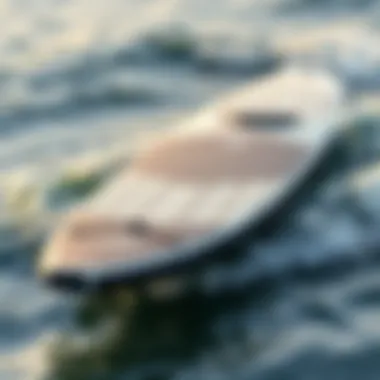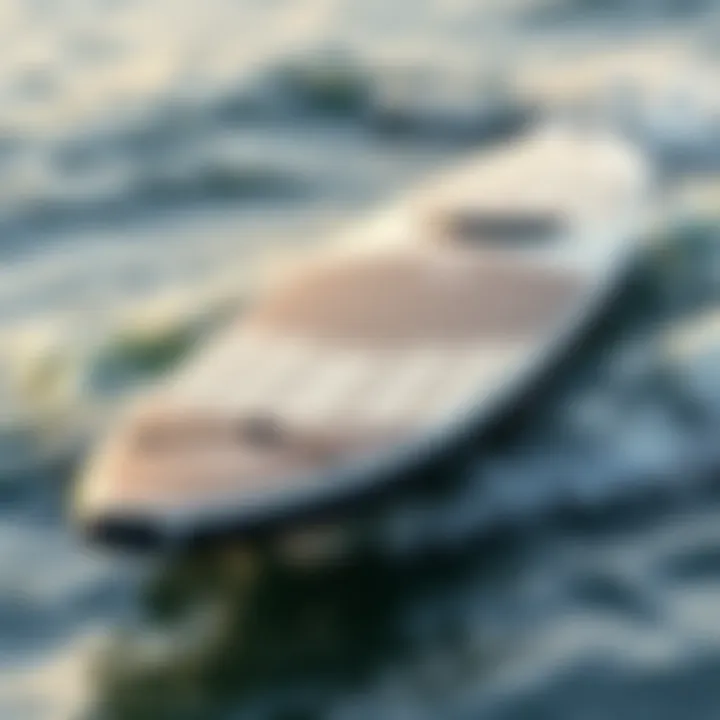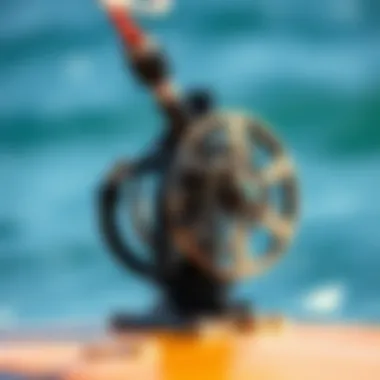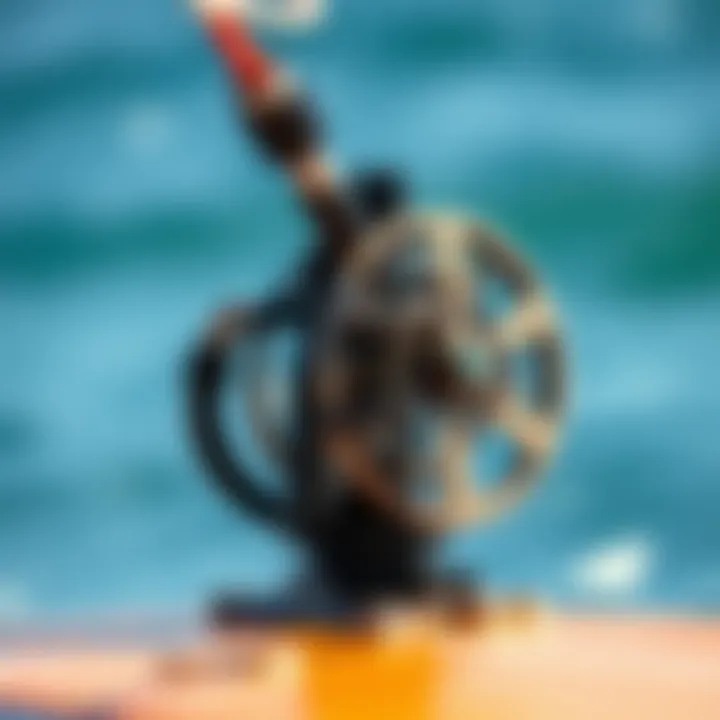Understanding Hydrofoil Surfing Boards: A Complete Guide


Intro
Hydrofoil surfing is quickly becoming one of the most exciting frontiers in the ocean sports realm. Unlike traditional surfing, where the board sits firmly on the water’s surface, hydrofoil boards have a unique design that raises them above the water when they reach a certain speed. This variety opens the door to a new world of movement and performance, allowing riders to glide smoothly, reducing drag and enabling a more fluid experience.
The hydrofoil itself consists of a wing-like structure attached to the board by a mast. This configuration not only grants the rider the ability to ride over surface chop but also transforms the way they interact with the waves. In this guide, we will explore the intricate details of hydrofoil surfing boards, covering everything from equipment specifications to techniques for riders at various skill levels.
Equipment Insights
Understanding the right equipment is crucial for optimizing performance and enhancing your hydrofoil surfing experience. Let's dive into some of the latest gear and the maintenance required to keep it in top shape.
Latest Gear Reviews
When seeking the perfect hydrofoil board, several brands stand out on the market. Some of the most notable ones include:
- Slingshot: Known for their innovative designs, Slingshot boards often feature adjustable foils suitable for various skill levels.
- Fanatic: This brand is noted for their durable materials and precise craftsmanship, making their boards a favorite among serious enthusiasts.
- Ozone: Ozone offers an array of hydrofoils with unique wing designs, allowing for superior lift and stability.
Each brand has its unique strengths, and choosing the right one depends significantly on your personal riding style and preferences. Be sure to read user reviews and seek recommendations within the hydrofoil community on platforms like reddit.com.
Essential Gear Maintenance
Keeping your gear in good shape requires diligence and care. Here are some maintenance tips:
- Rinse After Use: Always rinse the board and foil with fresh water after riding to eliminate salt build-up.
- Check for Damage: Regularly inspect for dings or cracks on the board and make necessary repairs to maintain performance.
- Foil Wing Care: Ensure that the wings are clean and free from debris. A soft cloth generally works well for this.
Proper maintenance not only prolongs the lifespan of your gear but also enhances your riding experience.
Technique Exploration
Whether you’re just starting or have been riding for years, fine-tuning your technique can significantly improve your hydrofoiling journey.
Beginner Techniques
For those dipping their toes into hydrofoil surfing, mastering basic techniques is essential:
- Balance: Stand centered on the board and focus on your core stability. An even weight distribution will make it easier to maintain balance.
- Starting Slow: Begin in flat water and gradually increase speed to allow the foil to lift. Patience is key here; rushing can lead to a nasty tumble.
Advanced Maneuvers
As your skills progress, consider exploring these advanced techniques:
- Carving Turns: Utilizing your weight shift, initiate turns by pressing down on the toe or heel of the board, allowing for smooth transitions.
- Jumping: Once confident, try adding small jumps. Initiate the jump by pressing down on the tail of the board while pulling up gently on the handlebars to maintain lift.
With a solid grasp of these techniques, you can unlock an exhilarating world of hydrofoil surfing that blends the thrill of surfing with the art of flying over the water.
"The beauty of hydrofoil surfing is found not just in the ride, but in the mastery over the elements, the wind, and the water."
As we further explore the intricacies of hydrofoiling, understanding how to manage equipment and refine skills lays the foundation for an exciting journey in this unique sport.
Understanding Hydrofoil Technology
Diving into the realm of hydrofoil technology is essential for grasping how this innovative approach revolutionizes water sports. The ability to glide above the waves offers not just excitement but also a multitude of benefits that set hydrofoils apart from traditional boards. This section elucidates the core elements of hydrofoiling, highlighting its mechanics, applications, and the overall impact on water sports culture.
The Evolution of Hydrofoils
Hydrofoil technology has deep roots, dating back to the early 1900s with its inception meant for larger vessels. Initially, they were used to improve efficiency in boats, allowing them to skim across the surface of the water rather than push through it. Fast forward to the late 20th century, and hydrofoils began finding their place in surfing. With designs becoming more refined, riders discovered that hydrofoils could elevate their surfing experience to another level by minimizing drag and maximizing speed.
Essentially, hydrofoils enable surfers to ride the energy of the water differently, heralding a new era where style meets engineering ingenuity. This evolution showcases how an idea can transform into a multifaceted sport that attracts enthusiasts of varying skill levels.
Mechanics of Hydrofoils
Hydrofoils operate on principles of physics that often elude casual observers. Understanding how these mechanics work is crucial for anyone interested in the sport.
Lift Generation
Lift generation is pivotal for hydrofoil performance. When the foil moves through the water, the unique shape and angle create a difference in pressure above and below the wing. This pressure difference results in lift, allowing the board to rise above the waves. Notably, a well-designed hydrofoil maximizes this lift while also remaining stable at higher speeds. This characteristic is what attracts riders to hydrofoiling as it permits them to glide effortlessly without being hindered by traditional wave conditions. The ability to generate lift seamlessly translates into an exhilarating experience as riders enjoy reduced contact with the water.
Drag Reduction
Drag is the enemy of speed, and hydrofoil designers are always on the lookout for ways to cut down resistance. Lower drag means that surfers can maintain higher speeds with less effort. Hydrofoils achieve this through streamlined designs that minimize turbulence in the water. The HD2 hydrofoil, for instance, features a streamlined profile that has been shown to reduce drag, enhancing overall performance. A hydrofoil with effective drag reduction can significantly improve ride quality, making it a favorite among racing enthusiasts. However, there’s a fine line; too much focus on reducing drag can negatively affect stability, which is crucial, especially for newer riders.
Stability Factors
Stability factors are a deciding point in a successful hydrofoil experience. Without stability, a rider risks losing control, especially under challenging conditions. Hydrofoils today are designed with certain geometries and materials that enhance balance. New learners benefit immensely from boards that offer passive stability through wide wings and increased surface area. For those pushing the limits, understanding how the center of gravity interacts with water currents can help in maneuvering smoothly through choppy conditions. Achieving that perfect balance between stability and maneuverability is a constant endeavor for both designers and riders.
Applications in Water Sports
Hydrofoil technology has quickly made its mark across a variety of water sports, changing the way enthusiasts interact with the ocean.
Surfing
Hydrofoil surfing has emerged as a thrilling variant of the sport. By applying hydrofoil principles, surfers can carve through waves with less resistance. This results in longer rides and smoother transitions even when traditional surf conditions aren't optimal. Riders appreciate the adaptability of hydrofoils, highlighting their capability to perform in smaller swells that might disappoint regular surfers.
Kiteboarding
Kiteboarding enthusiasts also have seen the advantages of hydrofoils. The lift generated allows them to jump higher and stay airborne longer, blending the thrill of flying with riding on water. A key characteristic of hydrofoil kiteboards is their ability to cut through water more cleanly, making for smoother landings on turbulent days. This aspect makes hydrofoil kiteboarding increasingly popular among those seeking adrenaline.


Windsurfing
In the windsurfing arena, hydrofoils have paved the way for an enhanced, more dynamic experience. They allow windsurfers to plane earlier and sail faster, even in lighter wind conditions. The unique interaction of wind and water beneath the board creates a sensation unlike any traditional setup. Yet, with innovation comes complexity; mastering the nuances of foil windsurfing might require patience when compared to riding standard boards.
By grasping the underlying mechanisms and benefits of hydrofoil technology, enthusiasts can make informed decisions that elevate their riding experience across various water sports.
Types of Hydrofoil Surfing Boards
The world of hydrofoil surfing boards is rich and diverse, catering to varying preferences and skill levels. Understanding the different types is pivotal for any rider looking to optimize their experience on the water. These boards are tailored to specific styles, conditions, and rider goals, making it significant to know which type fits your needs. Whether you are chasing thrills in freeriding or seeking competitive edge in racing, the right hydrofoil board can make all the difference.
Freeride Hydrofoil Boards
Design Features
Freeride hydrofoil boards are crafted for versatility and comfort. The design typically incorporates a larger surface area, allowing for easy lift and stability. One key characteristic is the rounded nose, which helps in navigating choppy waters smoothly. This design is beneficial for both newcomers to hydrofoiling and experienced riders looking to explore different wave conditions.
A unique feature of these boards is the adjustable foil mounting system. This system allows riders to fine-tune their foil placement, optimizing the balance and maneuverability according to the water state. However, riders might find that while they are great for cruising, these boards don’t excel in speed compared to their racing counterparts.
Performance Overview
In terms of performance, freeride boards are known for their balance between speed and ease of use. The wide stance makes it easier to get up on the foil, minimizing the learning curve for beginners. This performance characteristic indeed makes it a popular choice for those who want to enjoy long sessions without excessive fatigue.
Interestingly, the ride comes with its own quirks; greater buoyancy leads to a tendency for some riders to experience a slower response during turns. However, this is often offset by the overall stability and comfort offered during use.
Race Hydrofoil Boards
Speed Characteristics
Race hydrofoil boards are engineered for one thing: maximum speed. The sleek, elongated design reduces drag significantly, allowing riders to reach peak velocities. The key characteristic here is the narrow outline, which enhances hydrodynamics. This makes it a top pick for competitive riders seeking to shave seconds off their time.
One unique feature to highlight is the use of lightweight materials such as carbon fiber, which not only contributes to decreased weight but also improves responsiveness. While these boards are incredibly fast, they do demand high skill levels; inexperienced users may struggle with balance at high speeds.
Usability
Usability in race boards often comes into question given their specialized nature. They are specifically designed for speed, which means that they may not handle choppy water conditions as well as freeride boards. The narrow shape can feel twitchy to the inexperienced rider, making it essential for users to have a solid understanding of hydrofoil mechanics before jumping into a race setup. This is a beneficial choice for serious racers who prioritize speed over comfort in their ride.
Beginner Hydrofoil Boards
Accessibility
For those just stepping into the world of hydrofoiling, beginner hydrofoil boards are tailored for accessibility. They often feature broader dimensions and wider outlines, which significantly aid stability. The key characteristic is the larger surface area that assists in generating lift at lower speeds, making it easier for new riders to find their footing. A distinct feature is the thicker profile that adds buoyancy; this can make learning to foil less daunting. However, riders might lose out on some speed and performance compared to more advanced boards, which can dampen the thrill once they become more confident on the water.
Learning Curve
The learning curve on beginner boards is designed to be gentle. Their forgiving nature allows novice riders to familiarize themselves with hydrofoil techniques without excessive wipeouts. This is a beneficial aspect, particularly for those who might feel apprehensive about tackling this sport. It’s worth noting, though, that while these boards are easier to learn on, they may lag in performance as skills improve, gradually pushing riders to upgrade to more advanced options.
Advanced Hydrofoil Boards
High-Performance Features
Advanced hydrofoil boards are all about refining the riding experience. These boards are built with high-performance features like low drag foils and specialized bottom contours. One defining characteristic is the ability to track straight at high speeds while still providing agile handling during turns. This makes them a preferred choice for advanced riders seeking to push the boundaries of hydrofoiling.
Interestingly, some models have features such as adjustable angles for the foil, allowing for further customization based on individual riding styles. However, the complexity of these boards can be frustrating for those still developing their skills, necessitating a substantial commitment to mastering their use.
Customization Options
Customization is one of the standout features of advanced boards, with builders offering a range of modifications from fin setups to color schemes. This adaptability caters to individual preferences and specific riding types, enhancing the uniqueness of each rider's experience. The possibility to fine-tune aspects of the board is extremely attractive, yet it also has its drawbacks. Novices might find it overwhelming to navigate all the customization options, and poor decisions can lead to suboptimal performance.
Understanding these fundamental types of hydrofoil surfing boards allows enthusiasts and novices alike to make informed decisions tailored to their individual needs and riding experiences. Each type has its nuances, and accounting for these details can significantly enrich one’s hydrofoiling journey.
Selecting the Right Hydrofoil Board
Choosing the right hydrofoil board is more than just a trip to the shop; it's about finding the perfect match for your style, skill level, and specific conditions you will encounter on the water. The world of hydrofoil surfing can feel overwhelming, given the diversity of boards available. It’s essential to understand what makes one board better suited to your needs than another.
A well-chosen board not only enhances your surfing experience but also accelerates the learning process while ensuring safety and enjoyment on the waves. Here, we’ll break down key factors to consider when selecting the right hydrofoil board.
Skill Level Considerations
Beginner vs. Advanced
When you’re first dipping your toes into hydrofoiling, it’s critical to recognize the distinct needs of beginners compared to seasoned riders. Beginner boards often come designed with a larger surface area. This facilitates easier takeoff and stable flight, which can substantially reduce the learning curve. As newbies, riders often struggle with balancing and controlling the foil in the water. A board tailored for beginners typically offers additional buoyancy and a wider stance, creating stability as they learn to maneuver.
In contrast, advanced boards are designed with performance in mind. They are usually thinner and have less volume, allowing for precision and speed. Though these boards can be more challenging to handle, they offer the responsiveness that advanced riders crave for tricks and racing.
"The leap from a beginner board to an advanced one marks a significant milestone; it’s as if you’re trading training wheels for a sports car."
Advantages and Disadvantages:
- Beginner Boards: Great for stability and ease but may lack performance once foundational skills have been established.
- Advanced Boards: Offer speed and maneuverability but demand a higher skill level.
Specific Riding Styles
Every hydrofoil surfer has a style that meshes with their approach to riding. Be it carving on knee-high waves or racing across calm waters, selecting a board to suit that style is vital. For instance, carving boards typically have a shape that allows for tight turns and quick responses, which is essential for high-octane performance.
Freeride styles, on the other hand, call for boards that balance performance with ease of use. These boards often have a versatile design, allowing riders to switch between tricks and more sustainable cruising. The specific riding style one prefers heavily influences their choice of board.
Advantages and Disadvantages:
- Carving Boards: Enable sharp turns and agility but require more skill to manage.
- Freeride Boards: Useful for a variety of riding styles but may compromise performance in specialized situations.
Board Size and Shape
Volume and Dimensions


Volume and dimensions are fundamental characteristics that impact a hydrofoil board's buoyancy and handling on the water. A larger volume board provides more floatation, which is especially beneficial for beginners who are still mastering their balance. The width of a board can also influence stability; wider boards tend to feel more secure, making it easier to stand and ride, especially during choppy conditions.
Conversely, as riders advance, understanding that a more streamlined board with less volume can help with speed and agility is crucial. These designs support smoother transitions when lifting out of the water, leading to an overall enhanced performance.
Advantages and Disadvantages:
- Larger Volume Boards: Easier for beginners but might feel cumbersome to experienced riders.
- Streamlined Boards: Provide enhanced speed but can be trickier for novices.
Impact on Performance
The shape of the board directly contributes to how it performs in different water conditions. For example, a board with a pointed nose cuts through waves easily, providing a smoother ride. Meanwhile, a wider tail can translate to increased lift, allowing for an early takeoff. It’s a balancing act, and understanding how these characteristics shape the ride can guide your selection.
Advantages and Disadvantages:
- Pointed Nose Boards: Great for slicing through water but might be harder to control for those still learning.
- Wider Tail Boards: Help lift easily but require more skill to manage effectively.
Material Choices
Carbon Fiber
Carbon fiber is becoming an increasingly preferred material in the construction of hydrofoil boards. This choice comes down to its compelling properties like high tensile strength and lightweight. Given that hydrofoiling is all about gliding above the water, lightweight materials offer performance advantages. A carbon fiber board can be significantly more responsive, allowing for quick maneuvers and enhanced control.
However, the downside is that carbon fiber boards often come with a heftier price tag, which may not be feasible for all budgets. Still, for serious enthusiasts, the investment can yield substantial returns in terms of performance.
Advantages and Disadvantages:
- Lightweight and strong: Improves performance but sometimes costs more than alternatives.
Epoxy Resins
Boards made with epoxy resins also have their place. Known for durability and resistance to water damage, they can offer good performance at a more accessible price point. Epoxy boards generally provide enhanced buoyancy, making them user-friendly, especially for beginners. The downside? They can sometimes be a bit heavier than their carbon fiber counterparts.
Advantages and Disadvantages:
- Durable and water-resistant: Good for longevity but may lack some performance benefits compared to carbon fiber.
Choosing the right hydrofoil board is akin to finding the right pair of shoes; it’s all about comfort, fit, and how well it suits your adventures ahead. With informed decisions based on skill level, riding style, size, and material, you set yourself up for a much more rewarding hydrofoiling journey.
Techniques for Hydrofoil Surfing
Hydrofoil surfing is not just a new way to ride the waves; it's an intricate dance between rider, board, and water. Grasping the techniques essential to hydrofoiling is vital for enhancing performance and achieving the exhilarating experience that comes with gliding above the water. This section will cover crucial elements such as balancing techniques, maneuvering strategies, and the necessary safety practices to ensure a wholesome adventure.
Getting Started with Hydrofoiling
Balancing Techniques
Balancing is perhaps the cornerstone of successful hydrofoiling. Unlike traditional surfing where your board stays on the water, hydrofoiling involves maintaining stability while suspended above it. A key characteristic of balancing techniques is the need for a steady center of gravity. By keeping your knees slightly bent and shifting your weight to your back foot, you can help the board remain steady while the foil generates lift. This makes it a popular choice for riders aiming to develop confidence early in their hydrofoil journey.
One unique feature of effective balancing is the use of your arms as stabilizers. Extending them out can significantly help maintain your balance. Advantages of mastering these techniques include improved confidence on the board and a greater ability to react to various water conditions. However, be aware that inadequate balancing can lead to falls, which underscores the need for practice and awareness of your body’s movements during riding.
Initial Setup
The initial setup of your hydrofoil board is another crucial factor. This includes positioning your foot straps, balancing the board, and checking the foil height. A key characteristic of an effective setup is ensuring your foot straps are snug yet comfortable. This helps you maintain control while still being able to quickly disengage in case of a fall.
One unique aspect of setting up is the adjustment of the foil’s angle. Experimenting with the angle where the foil meets the water can significantly alter performance. A higher angle produces more lift but less stability, while a flatter angle ensures a smoother ride but can reduce lift. Advantages of finding the right setup include more seamless transitions into foiling and the ability to handle a variety of wave sizes. Remember, figuring out your ideal setup takes time and experimentation, so don’t be afraid to fiddle and find what works best for you.
Turning and Maneuvering
Carving Turns
Carving turns is a delightful part of hydrofoiling that brings out the thrill in the sport. The characteristic of carving turns lies in utilizing your body weight to shift your board seamlessly from side to side. To execute a proper carving turn, you need to lean into the direction of your turn while keeping your center of gravity low.
One remarkable feature of carving turns is their ability to maintain speed while changing direction, something that traditional surfing boards may not accomplish effectively. Advantages of mastering this technique include fluid movements and increased ride enjoyment—turns become almost effortless with practice. On the flip side, failing to carve correctly can lead to abrupt stops and instability, making balance exploration essential.
Maintaining Speed
The capacity to maintain speed while hydrofoiling directly influences your ride. A vital aspect of this technique is understanding how to harness the lift generated by the hydrofoil while minimizing drag. Key characteristics include staying low and keeping your movements smooth. A common pacing strategy is to keep your body centered over the board, guiding it gently to maintain a natural flow over the water's surface.
One unique aspect of speed maintenance is timing your movements with the foil’s lift. Advantages here revolve around extending your ride and capturing more of the wave energy, making every session feel longer. Yet, it’s important to note that maintaining speed requires constant attention, as even minor adjustments can lead to fluctuations in your glide.
Safety Tips and Practices
Essential Gear
Safety gear plays a crucial role in any sport, and hydrofoiling is no exception. Key pieces of safety equipment should include a well-fitted helmet and impact vest. The characteristic of this gear is that it provides vital protection when you're just starting—falls are likely as you learn to balance and maneuver.
One unique aspect of wearing safety gear is getting accustomed to it; it can initially feel cumbersome but investing in quality gear is essential for peace of mind. Advantages range from reducing the risk of injury to instilling a sense of confidence on the water. However, the downside is that it may take a little getting used to, as it can feel restrictive initially.
Fall Techniques
Recognizing how to fall safely is just as crucial as learning to ride. A significant aspect of fall techniques is knowing to fall away from the board to avoid potential collisions. When falling, try to relax your body and roll, rather than stiffen. This allows you to absorb some impact.
One unique feature of effective fall techniques is positioning—falling backward can help you steer clear of the board and the occasional buckle from the hydrofoil. Advantages include reduced risk of injury and faster recovery back to riding. On the other hand, improper falling can lead to serious injuries, so continual practice of the fall technique is advised.
Remember, the goal is to become one with the board and the water. Mastering these techniques will take time, but persistence pays off in big waves.


Advantages of Hydrofoil Surfing Boards
The advent of hydrofoil surfing boards has sparked considerable interest among water sports enthusiasts. The allure of these boards extends beyond mere aesthetic appeal; they present numerous advantages that redefine the surfing experience. When discussing hydrofoil surfing, it's essential to focus on three key advantages that highlight the strengths of this exhilarating sport.
Enhanced Speed and Efficiency
One of the most impressive aspects of hydrofoiling is the ability to achieve greater speeds with significantly less effort. Hydrofoil boards use a wing-like structure submerged beneath the water, which generates lift and elevates the board above the surface. This elevation minimizes drag, allowing riders to glide effortlessly, cutting through water with less resistance. As a result, even if the swells are less than ideal, riders can maintain a rapid pace. This enhanced speed isn't just about adrenaline; it also translates to longer rides without feeling fatigued.
- Increased Speed: Riders can experience speeds that traditional surfboards often struggle to achieve.
- Efficiency: Less effort is required for propulsion, which means more time spent riding.
- Long-range potential: The efficiency of hydrofoil boards makes them suitable for longer excursions, allowing riders to explore new areas with decreased fatigue.
The ability to ride anything from small ripples to substantial swells opens up a broader range of conditions for hydrofoil surfers, making it a versatile choice for exploring the ocean.
Reduced Wave Dependence
Another major benefit of hydrofoil boards is their decreased dependency on sizable waves. Traditional surfing is often reliant on the availability of quality waves, which can be somewhat hit or miss based on location and tide. However, hydrofoils operate effectively even in flat water or marginal conditions. The lift generated by the hydrofoil means that riders can enjoy their time on the water without having to wait for the perfect wave. This opens up opportunities for:
- Exploring various environments: From lakes to rivers and coastal areas where waves might be scarce, hydrofoil surfing can be done in many settings.
- Increased accessibility: For those new to surfing, the reduction of wave dependency allows for a more forgiving and enjoyable learning experience.
- Extending riding seasons: Riders are not confined to a specific season or conditions, making hydrofoiling a year-round sport.
Unique Riding Experience
The experience of surfing on a hydrofoil board is unlike traditional surfing. It merges agility with a sense of weightlessness, providing a truly unique sensation. Riders often describe the feeling akin to flying over the water's surface, which is a stark contrast to the conventional surf experience. This novelty can be more than just thrilling; it also promotes creative riding styles and tricks that are harder to achieve with standard boards.
- Sense of Weightlessness: Riders feel as if they are floating, making for an exhilarating experience.
- Possibilities for Tricks: The unique mechanics of hydrofoiling open doors to various tricks and maneuvers, enriching the overall experience.
- Connection to Nature: Riders often say that being elevated above the water creates a greater connection with the ocean, leading to a more immersive experience.
The combination of enhanced speed, reduced reliance on wave conditions, and a unique riding sensation makes hydrofoil surfing an appealing choice. For enthusiasts and newcomers alike, these advantages demonstrate not just the innovation behind hydrofoils, but their capacity to transform the water sports landscape.
Challenges and Considerations
As exciting as hydrofoil surfing can be, it brings to the table various challenges and considerations that can’t be overlooked. Understanding these elements not only helps enthusiasts anticipate possible hurdles but also enhances overall enjoyment of the sport. Whether one is a novice or seasoned rider, these challenges shape their experience on the water. This section delves into three primary considerations: the learning curve, environmental factors, and equipment costs.
Learning Curve and Adaptation
Learning to hydrofoil is akin to riding a unicycle at first – it's not the simplest endeavor. Riders often find themselves spending considerable time getting comfortable with the board and the technique. The adaptation process usually includes a number of falls and adjustments. You may begin by mastering basic balancing techniques on a regular board before transitioning to a hydrofoil. Practicing in calm conditions can aid in easing into the unique feel of flying above the water instead of skimming across it.
Recognizing that it may take multiple sessions to get the hang of things is crucial. Riders should adopt a patient mindset, allowing for mistakes and gradual improvement. As the old saying goes, "No guts, no glory."
Environmental Factors
When it comes to hydrofoiling, environmental factors can greatly influence the experience. Two primary elements come into play here: wind conditions and water state. Each of these factors can either make or break a day on the water.
Wind Conditions
Wind conditions hold immense significance for hydrofoiling, influencing both the ride and the safety of riders. Ideally, a moderate breeze is what most hydrofoilers seek. Gentle, consistent winds allow for smoother take-offs and better control of the board. In choppy waters, strong winds can create turbulence, making it tougher to maintain balance.
One key characteristic to remember is that too much wind can lead to difficulty, especially for novices. It’s not uncommon for inexperienced riders to feel overwhelmed when the winds pick up. Herein lies the balance; finding a location known for favorable winds can make learning and riding considerably more enjoyable. However, do keep an eye out because what feels like a pleasant breeze might turn into a gusty foe.
Water State
Water state, encompassing waves and surface roughness, also plays a pivotal role in hydrofoiling. Calm waters are the preferred playground for learners as they facilitate easier balance and a smoother ride. Choppy waters can be intimidating and make gliding tougher.
Another unique feature of water state is that as a rider becomes more experienced, they might seek out varying water conditions to push their limits. Advanced riders often find sensation in carving through waves. Nevertheless, understanding one’s own skill level is crucial in selecting suitable conditions. Too much wave activity can lead, unfortunately, to more tumbles than triumphs.
Equipment Costs
Investing in hydrofoiling equipment can raise eyebrows for newcomers. Unlike traditional boards, hydrofoil boards are typically more expensive due to their construction and materials used. One must consider not just the foil and board, but also associated costs for necessary gear like a wetsuit or other safety measures. A budget-friendly tip is to look into second-hand boards or rentals initially, as this allows potential riders to test the waters before committing to a full purchase.
That being said, while the initial investment might seem steep, the satisfaction and unique experience of hydrofoil surfing often justify the expense. Riding a hydrofoil is not just about the cost; it's about the thrill of flying above the water, and that undeniable feeling is something one won’t forget easily.
Hydrofoil surfing combines elements of thrill and challenge; the rewards are truly significant for those willing to invest the time and resources.
Future Trends in Hydrofoiling
The world of hydrofoiling is evolving at breakneck speed, influenced by technological advancements and growing interest in water sports. Understanding future trends in hydrofoiling is crucial not only for enthusiasts looking to stay ahead but also for manufacturers and instructors keen on maintaining relevance in a competitive landscape. The innovations that are emerging are not mere novelties; they offer substantial enhancements in performance, user experience, and safety.
Technological Innovations
Smart Hydrofoils
One intriguing aspect of hydrofoiling's future is the rise of smart hydrofoils. These boards incorporate sensors and software that provide real-time data about the rider's performance, water conditions, and board dynamics. A standout characteristic of smart hydrofoils is their ability to adapt performance based on the rider's skill level and riding style. For example, they can suggest optimal trimming adjustments for novice riders, thus facilitating a smoother learning curve. The responsiveness of smart hydrofoils makes them immensely beneficial, offering users insights that can elevate their riding experience.
However, the technology does come with a catch. While the added data can lead to significant improvements in technique, it also raises the bar for engagement. Riders who prefer a more traditional or minimalist approach to their sport might find it a bit overwhelming or even distracting. Ultimately, whether seen as an advantage or disadvantage, smart hydrofoils illustrate the trend towards a data-driven approach in hydrofoiling.
Materials Advancements
Another area witnessing remarkable growth is materials advancements. Innovations like lightweight composite materials and stronger, more flexible alloys are reshaping how boards are designed and built. A key characteristic here is the balance between strength and weight. Modern hydrofoils are being crafted to be lighter without sacrificing durability, thus enhancing the overall performance.
These material advancements also open the door to customization options. For instance, riders could select specific materials based on performance needs, like speed or maneuverability. Nevertheless, the downside is often the cost; specialized materials can significantly hike up prices. Thus, while advancements in materials boost usability and performance, they could pose a barrier to some, making it essential to find the right balance between cost and capability.
Community and Sport Growth
Local Competitions
The surge in local competitions has fostered a vibrant community of hydrofoiling enthusiasts. These events not only showcase talent but also cultivate camaraderie among riders. A notable aspect of local competitions is their accessibility. They tend to involve a diverse range of skill levels, encouraging newcomers to participate and learn from more experienced riders. This inclusivity serves as a significant motivational factor for many.
However, despite their advantages, local competitions often struggle with resources and organization. Participation hinges on community involvement and local sponsor support, which can vary significantly from one area to another. Nonetheless, local competitions play a pivotal role in nurturing interest and skills among novice riders, providing a solid foundation for the future of the sport.
International Events
On a larger scale, international events are poised to bring hydrofoiling into the global spotlight. These events not only allow riders to showcase their skills but also serve as platforms for innovation demonstrations by brands and manufacturers. One of the prominent features is the high level of competition, which often raises the standards of performance and safety across the board. The excitement surrounding international events can spark increased interest and participation back home.
However, the scale of these events often comes with logistical challenges and can become expensive for riders. Not everyone can participate due to qualification and travel requirements. But when executed well, international events can become catalysts for growth, making hydrofoiling a recognized sport around the world.







